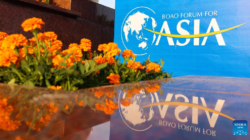China’s lunar sample-collecting mission from the far side of the Moon embarks on its journey as the Long March 5-Y8 rocket lifts off on Friday from Wenchang Spacecraft Launch Site in south China’s Hainan province, sending the Chang’e 6 probe into its orbit.
Scientists and engineers from countries like France, Italy, Sweden and Pakistan, representatives from global space agencies like United Nations Office for Outer Space Affairs(UNOOSA), International Astronautical Federation (IAF), Asia Pacific Space Cooperation Organization (APSCO) have been invited to witness this historic moment on-site. Domestic and international journalists, hundreds of thousands of tourists have come to Wenchang city. Space enthusiasts around the world will be watching the launch online, demonstrating people’s high expectations for this lunar sample return mission.
Objectives of Chang’e 6 mission
It will take about 53 days to finish the whole Chang’e 6 mission. The Chang’e 6 probe consists of a lander, an ascender, orbiter and returner. After several days of flight, the Chang’e probe will enter the lunar orbit and plans to land at the south pole Aitken basin on the far side of the moon – with the help of Queqiao-2 relay satellite.
It will collect lunar rocks and soil samples from the far side of the moon and carryout scientific exploration. After the completion of sample collection, the ascender will take off from the lunar surface, and that’ll be followed by lunar orbit rendezvous, docking and sample transfer. Thereafter, the returner will re-enter into the atmosphere, bringing precious lunar samples to Earth.
Scientists estimate the whole process of Chang’e 6 mission will last about 53 days. This is one of the most challenging space missions for China, as no country has ever brought back samples from the dark side of the moon.
International scientific payloads
Chang’e 6 probe also brought some international scientific payloads, including the French space agency’s DORN instrument, which measures radon on the moon’s surface. Then there are the Negative Ions at the Lunar Surface (NILS) payload from the European Space Agency and a laser retroreflector from Italy. These instruments will help us learn even more about the far side of the moon. A cube satellite ICUBE-Q , co-developed by Chinese and Pakistani scientists, is also in the lunar orbit, alongside the Chang’e-6 probe. It has been conducting a range of scientific experiments.
What can we expect from future lunar missions?
After the Chang’e6 mission, China aims to launch Chang’e 7 and Chang’e 8 missions over the next few years, paving the way for establishing an international lunar research station with global partners. The ultimate goal is to create a sustainable human presence on the moon. All these missions are open to international collaboration.
The Chang’e-7 probe will be sent around 2026 to implement resource exploration of the lunar south pole, one of the oldest and largest impact craters on the moon. The mission will carry out detailed surveys to assess the terrain, resources, and environment of the lunar south pole region.
Chang’e-8, slated for 2028, will conduct experiments on lunar resource utilization and build the basic model of the lunar station, according to CNSA. Chinese astronauts are expected to land on the moon before 2030.
International Lunar Research Station
China will work alongside its international partners to build a long term scientific research base on the moon called the International Lunar Research Station .It’ll be constructed on the lunar south pole. Russia, Venezuela, South Africa, Azerbaijan, Pakistan, Belarus – over 10 countries have signed agreements with China on the research base.
“Scientists, astronauts, engineers and pilots from across the globe are welcome to join these lunar programs. We aim to involve more countries, especially BRICS nations, the Asia-Pacific region, including Southeast Asia, and Latin American countries,” said Wu Weiren, Chief Designer of the China Lunar Exploration Program.
It is human nature to venture into the unknown. The moon is like a starting point, and the International Lunar Research Station will provide a platform for long-term research and experiments, paving the way for humanity’s journey deeper into space.
858 total views, 9 views today



















